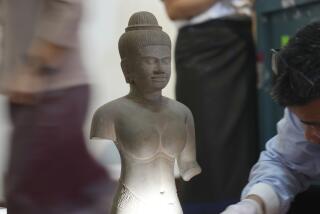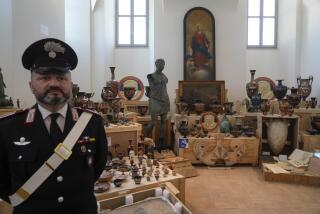Culture : Egypt Unwraps a Dispute on Antiquities : Is it worth the risk any more to send priceless treasures abroad? Some experts say not, and a Cairo court has demanded the return of an exhibit from Japan.
CAIRO — His golden face, serene in its youthful majesty, has enchanted millions who sought in it a glimpse of Egypt’s Pharaonic past. But ever since Egypt’s King Tutankhamen treasures went on traveling exhibit at museums around the world, there has been a nagging question about the famous burial mask: Is it real? Or was it switched?
The longstanding suspicion that a fake mask was substituted in an exhibit in Japan--a rumor ridiculed by most Egyptologists but that persists nonetheless--has fed a growing tide of discontent here over the country’s traveling antiquities exhibits. It now threatens the future of Pharaonic exhibitions worldwide.
In a case brought by archeologists and academicians who fear Egypt is risking its cultural heritage by sending it out on the road, a Cairo court ruled earlier this month that a major new exhibition of Egyptian antiquities in Japan is illegal and ordered its immediate return.
The decision raises doubts about Egypt’s ability to send its prized antiquities to international museums, a program through which millions have discovered the treasures of the country’s 5,000-year-old civilization.
The legal battle underscores growing political rifts within the Egyptian Antiquities Organization, which oversees archeologists and adventurers from around the world and some of the most priceless antiquities in the Middle East. It is an authority already rife with intrigue and ferocious back-biting.
The controversy has raised serious questions in Egypt, a poor, populous nation seeking to capitalize on its heritage to boost its revenues. Critics ask: How much is the country risking its ancient treasures in an effort to make them more accessible to the international public and more lucrative for the government?
Egyptian officials say the items are pointless if no one sees them. They say the international exhibitions of Pharaonic treasures have not only raised millions of dollars in revenues but boosted tourism and opened a window on the world to Egypt.
“We have built up in the last 20 years with these exhibits a wonderful image of Egypt in the outside world. It helped us very much in letting the world understand our point of view, to understand Egypt’s role in the Middle East, especially after its peace treaty with Israel,” said Mohammed Saleh, director of Cairo’s Egyptian Museum.
Opponents include Aly Radwan, dean of archeology at prestigious Cairo University, and others who believe that the money and prestige Egypt earns by sending its antiquities abroad are not worth the risk to a heritage that is priceless.
Neemat Ahmed Fouad, professor of Egyptology at Helwan University and a well-known writer on archeological issues, argues: “There is now a diarrhea of these exhibits, and for what? We are sending away to every country in the world the most precious gifts we have. Do we knock on everybody’s door and say, ‘Here are our antiquities, take them’? Or do we wait for people to come here to see them?”
The underlying feelings in the debate go back to the last century, when Egyptians watched helplessly as European and American archeologists uncovered the secrets of Egypt’s past and carried them away to museums and galleries abroad.
The 1952 revolution that eliminated Britain’s influence in Egypt also brought a new sense of nationalism to Egyptology, and foreign archeologists work in Egypt now only under strict controls. The antiquities organization is controlled by a cadre of experienced Egyptian professionals.
Farouk Hosni, the culture minister and an artist with strong ties to the West who has been behind the move to open up Egypt’s culture to Western sensibilities, has run afoul of the nationalist tide in the current debate; the controversy has focused not only on foreign exhibitions but also on expanding public use of Egyptian temples and monuments for theater performances and concerts.
A storm erupted over the ministry’s plans to build a 17,000-seat amphitheater at the base of the Sphinx--a plan later withdrawn. Another blew up when the ministry tentatively talked about concerts at the temple of Hatshepsut in Luxor.
“The department has turned a deaf ear to the cries of all concerned lovers of Egypt and of Egyptian art and history,” said newspaper columnist Mohammed Shebl in a “Stop the Concerts!” plea two years ago.
“Can people sleep safely at night with nightmares of ‘megaspeakers’ thundering the ‘Ode to Joy’ and the aroma of freshly grilled steaks, competing for livelihood with age-old colored drawings of Horus and Anubis, while the admiring claps of thousands of spectators slap the pharaohs and queens of Egypt across their faces?” he demanded.
Fouad, sitting in her Cairo apartment cluttered with old vases and paintings, was more succinct in her discussion of the culture minister’s plans for Egypt’s antiquities. “If the devil was in his place,” she said, “he would not destroy Egypt like this.”
Egypt’s exhibitions abroad began in the modern era at the Exposition Universale in Paris in 1867, when the nation dispatched figurines of the Pharaoh Khafra and Sheik al Balad and the jewels of Queen Iah-Hotep to the international fair.
But the showings really took off beginning in 1976, when the treasures of young King Tut attracted enthusiastic American and British audiences, amassing $9 million for Egypt. The Tut exhibit appeared at the Los Angeles County Museum of Art in 1978. It was followed by a growing number of international exhibits, including “Egypt Today”; “The Golden Pharaoh,” a popular collection of items from the period of Ramses II, and “Pharaohs’ Gold.”
The current 72-piece exhibit of items depicting the lives of Egyptian women from the Old, Middle and New Kingdoms, “The Ancient Queens of Egypt,” debuted last week at the Edo-Tokyo Museum; it contains some of the museum’s most valuable items, including sculpted heads of Hatshepsut and Cleopatra.
An administrative court in Cairo ruled the antiquities are the “property of the Egyptian people and state, and transferring their ownership to an authority or organization, which would deal in them, is inconceivable.” It said it was the responsibility of the president of Egypt to approve all programs for outside exhibitions.
In arguing their case, archeologists have pointed to a history of damage--most of it minor--to antiquities exhibited. The harm includes breakage of the headpiece of the goddess Selkit in the King Tut exhibit (the work later was restored); after the Ramses II exhibit in America, experts found that 22 items in the 25-piece collection had damage, mostly scratches; a 1988 Australian display left some pieces discolored (that too was later repaired).
“Of course, damage can happen anywhere. Even in the museum here, when you are cleaning a showcase, it can happen,” said Abdel-Halim Nureddin, director of the antiquities organization. “We have had a few cases where there was a kind of slight damage. A scratch. Because of that, we have insurance.”
The Tokyo exhibit is insured for $24.5 million and will earn Egypt about $1.7 million. Egyptian authorities emphasize it does not include, as critics allege, masterpieces from the museum in Egypt. Rather, they said, it features statues similar to some of the best-known pieces but of lesser quality.
Officials of the antiquities organization said they would immediately appeal the court ruling; in the interim, they plan to leave the Tokyo exhibition in place.
More to Read
Sign up for Essential California
The most important California stories and recommendations in your inbox every morning.
You may occasionally receive promotional content from the Los Angeles Times.










